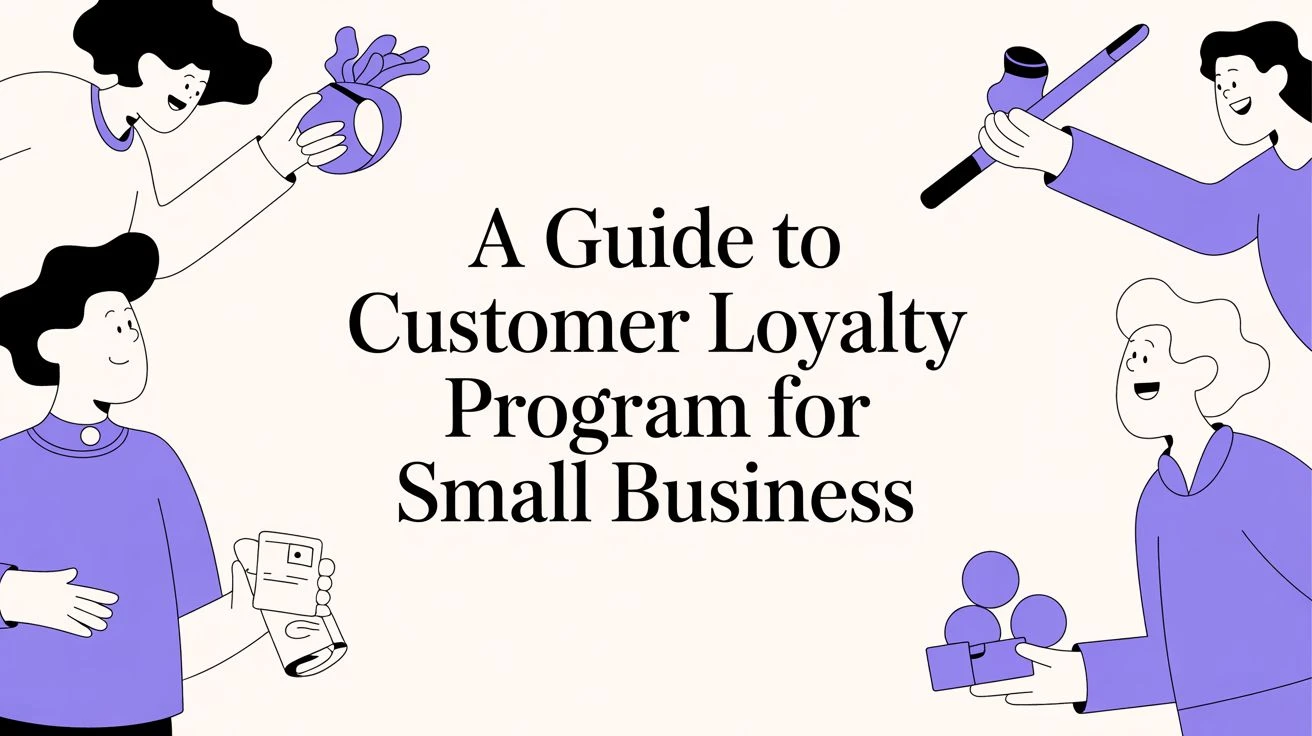A well-designed customer loyalty program for small business isn't just another marketing gimmick; it’s a core strategy for survival and growth. It’s how you turn casual shoppers into devoted regulars and modest profits into a reliable revenue stream-all by focusing on the customers you already have instead of constantly chasing new ones.
Why Your Small Business Needs a Loyalty Program
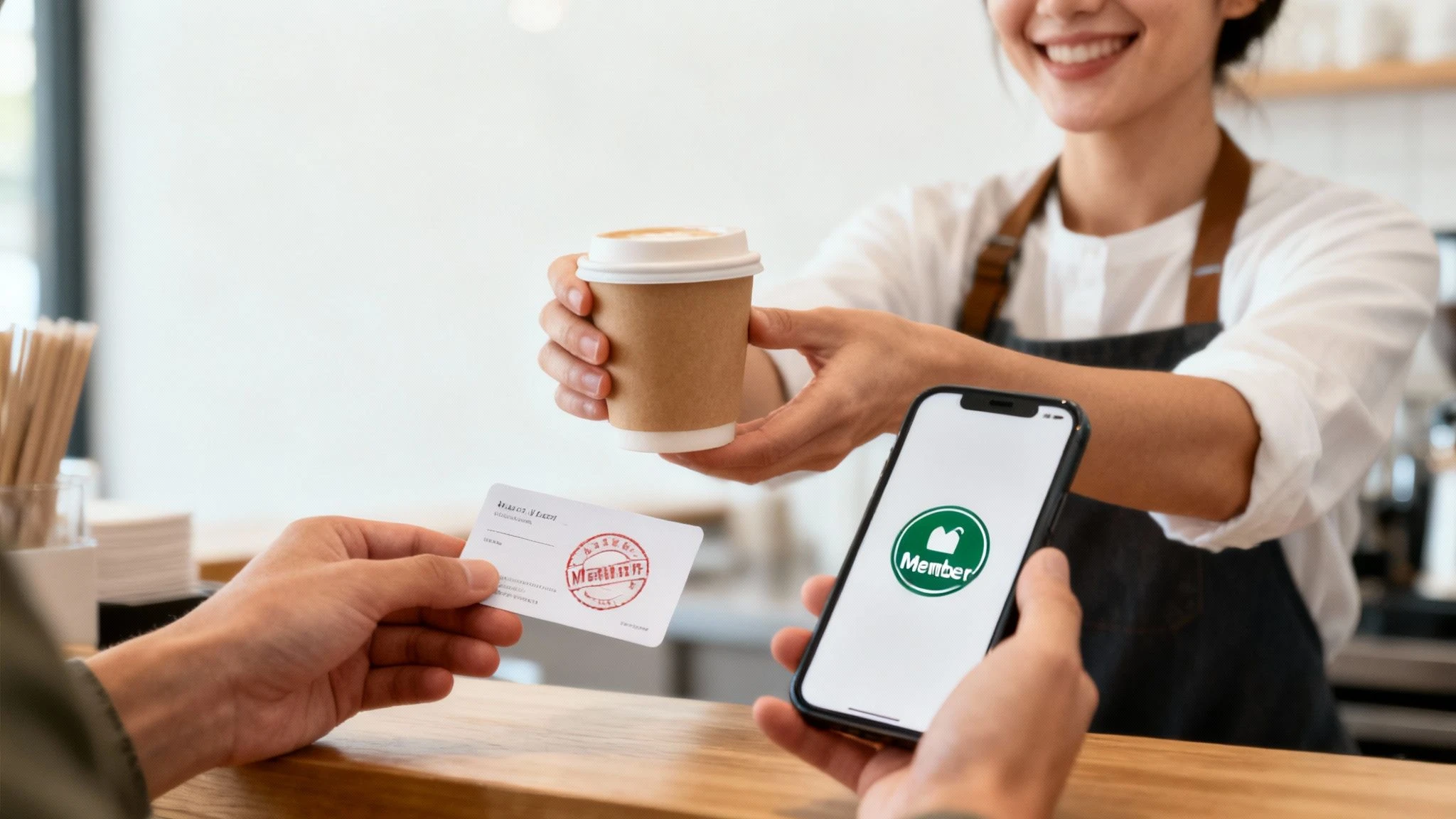
Let's be real. As a small business, trying to compete with the big players on price is a race to the bottom you can't win. Your real advantage is in building genuine relationships and creating a community around your brand. This is where a loyalty program becomes one of your most powerful tools.
It’s your structured way of saying "thank you," giving customers a concrete reason to walk past a competitor and come back to you.
The numbers don't lie. Bringing in a new customer can cost five times more than keeping an existing one. And those loyal customers? They spend more over time. Just think about your favorite local coffee shop. That simple "buy nine, get the tenth free" punch card can turn a one-time visitor into a daily regular, completely changing that customer's lifetime value.
The Tangible Return on Investment
It's a common myth that loyalty programs are too complicated or expensive for a small operation. The truth is, the return on investment (ROI) is one of the strongest arguments for starting one. This isn't about giving away free stuff; it's about encouraging behavior that directly grows your business.
Study after study confirms that people actively seek out and stick with brands that reward them. In fact, a staggering 84% of consumers say they’re more likely to stay with a brand that has a rewards program. On top of that, 70% of consumers are more likely to recommend a brand with a good loyalty program-and for small businesses that live and die by word-of-mouth, that’s huge.
The core purpose of a loyalty program is to increase customer retention. Even a small 5% increase in customer retention can boost profits by as much as 95%.
More Than Just Discounts
Beyond the direct financial boost, a loyalty program offers other massive benefits. It opens up a direct line of communication with your most dedicated customers and gives you priceless data on what they buy and when. This insight allows you to create personalized offers they'll actually want and make smarter decisions about your inventory.
For any small business, a loyalty program is a cornerstone of smart growth. To see how it fits into the bigger picture, it's worth exploring other powerful customer retention marketing tactics. These programs give you a competitive edge built not on deep discounts, but on genuine recognition and appreciation-the perfect foundation for long-term, sustainable success.
Designing a Program Customers Genuinely Value
A great customer loyalty program shouldn't feel like a marketing scheme. It should feel like a genuine thank you. The whole point is to move past generic templates and build something your customers will actually use and talk about.
Your first big decision is the structure. Are you going for instant gratification, like a digital punch card, or long-term engagement with a points-based system? A coffee shop might kill it with a simple "buy nine, get one free" digital card-it’s fast, clear, and fits the daily coffee run perfectly. On the other hand, a retail boutique could get more mileage from a points system that encourages customers to save up for a bigger, more aspirational reward.
Choosing Rewards with High Perceived Value
Here’s the secret to a profitable program: offer rewards that feel like a big deal to your customers but have a low actual cost to your business. This is where a little creativity goes a long way. Think about what makes you unique and where your margins are healthiest.
Need some inspiration? Here are a few ideas I've seen work wonders:
- For a salon: Forget a simple discount. Offer a free add-on service like a deep conditioning treatment with their next haircut. The perceived value is high, but your product cost is tiny.
- For a bookstore: Grant exclusive early access to a new release from a local author or a members-only book club meeting. This builds a real sense of community and costs you nothing.
- For a restaurant: Give them a complimentary dessert or appetizer on their next visit. These items usually have fantastic profit margins.
The most effective loyalty programs balance tangible rewards with emotional connection. Customers want to feel recognized and appreciated, not just part of a transaction. That sense of belonging is your biggest advantage over larger competitors.
Aligning Your Program with Customer Expectations
You have to understand what actually motivates your customers to stick around. Sure, discounts matter, but they aren't the whole story.
Recent data shows that by 2025, 55% of consumers will expect better deals as the foundation of their loyalty, and 50% want loyalty points or cashback. But look closer-the experience is catching up. 28% want seamless interactions, and 24% are more loyal to brands that send them personalized deals. You can dig into more of these insights in this Emarsys report.
What does this tell us? While the rewards need to be solid, the program itself has to be incredibly easy to use. A quick QR code scan at checkout is way more appealing than a clunky sign-up form. If you're leaning toward a points system, it's critical to get the structure right from day one. You can learn more by checking out these 6 golden rules for setting up a successful loyalty program with points. The right design makes your program feel like a special perk, not another chore.
Launching Your Program With BonusQR
You’ve sketched out a loyalty program on paper-now it’s time to bring it to life. BonusQR makes that leap effortless, even if you’re not a tech expert. Your aim is simple: recreate the friendly vibe of your storefront in a digital format that feels just as welcoming.
Start by building your digital card. This isn’t just a functional step-it’s a prime branding moment. Upload your logo, select your brand colors, and choose a background image that tells your story. Picture a neighborhood bakery featuring a mouthwatering croissant photo on the card itself. These small touches let customers know your program is truly yours.
Next, translate your rewards into clear targets. If you opt for a punch-card style, decide how many scans unlock a perk. For example, 10 stamps could earn someone a free coffee. It’s straightforward, motivating, and keeps customers coming back.
This infographic breaks down the three core phases-structuring goals, rewarding visits, and adding your personal flair.
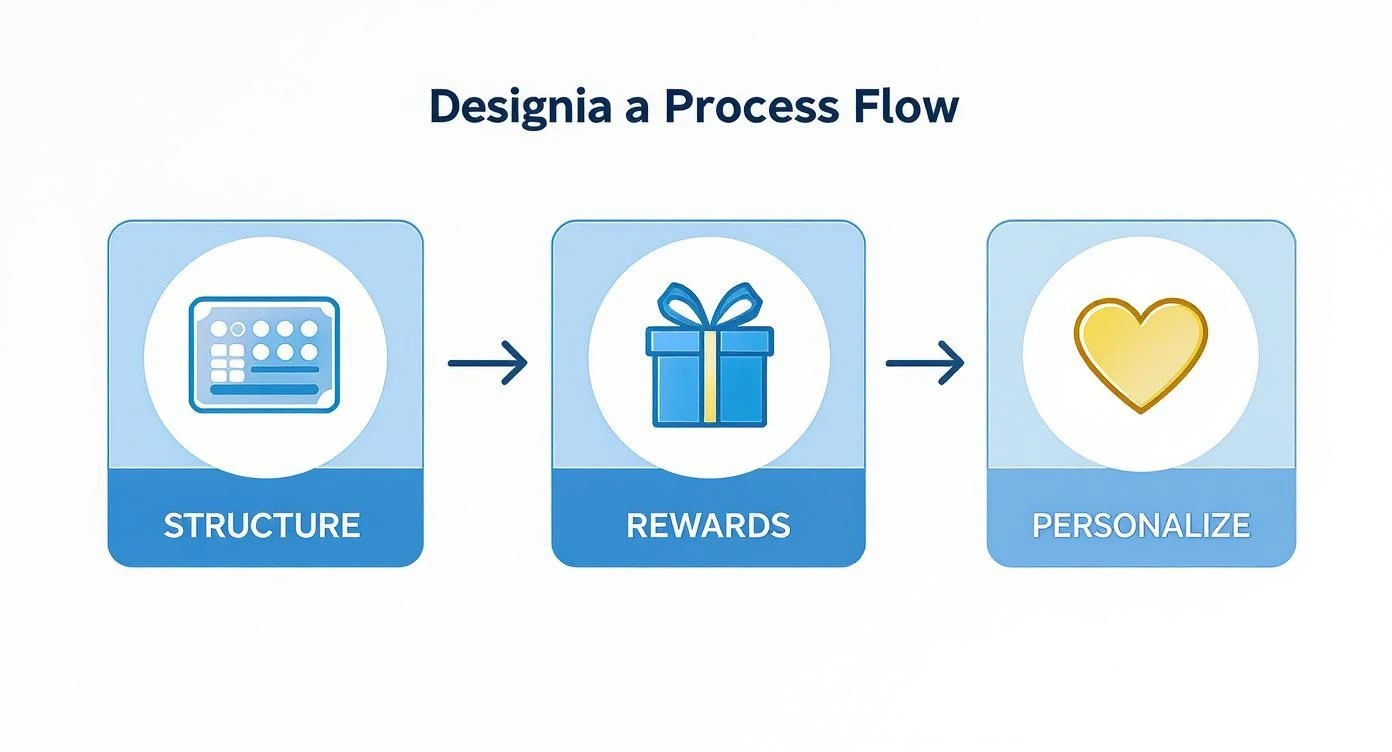
These steps form the backbone of a successful loyalty program: clear structure, enticing rewards, and branding that resonates.
Activating And Placing Your QR Code
Once your card design and reward milestones are set, BonusQR generates a unique QR code. This is the doorway to your loyalty club. Your next mission? Make it impossible to miss.
Think about the customer journey from the moment someone walks in. Where do they pause or scan their eyes? Those spots are prime real estate for your code.
- At The Register: A small sign or sticker with the QR code right where customers pay is essential. Encourage your team to say, “Want to join our free rewards program? Just scan here.”
- On Menus And Table Tents: In cafés and restaurants, diners have a moment to spare. A QR code on the menu or tent invites them to sign up while they decide.
- In Takeout Bags: Slip a flyer or sticker into every bag. It’s a gentle nudge for customers to join from home-and an incentive to order again.
- On Your Website: Feature the QR code on a dedicated section of your site-especially if you offer online ordering.
Here’s a snapshot of BonusQR’s dashboard-clean, intuitive, and built to get you up and running fast.
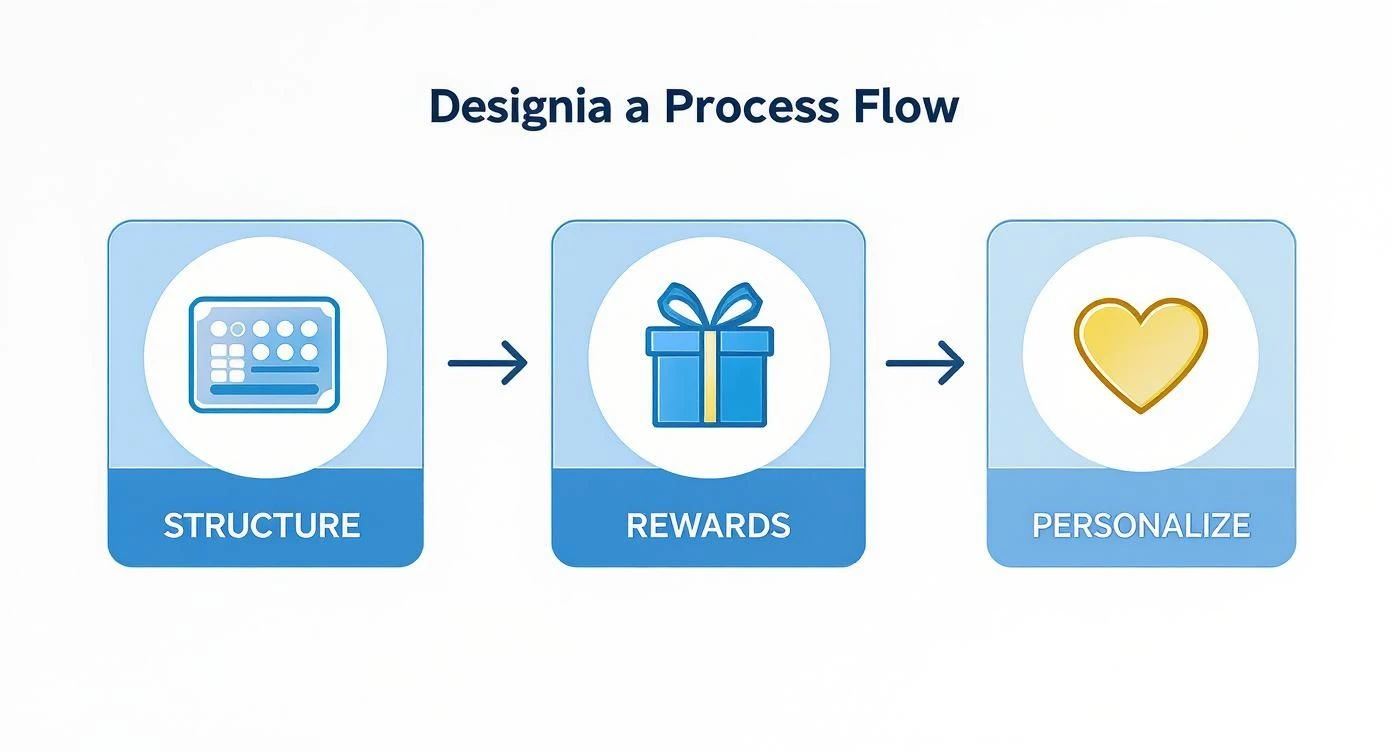
With this user-friendly interface, launching your customer loyalty program for small business feels more like a few clicks than a full tech overhaul.
Key Takeaway: Embedding your QR code into everyday touchpoints-and bringing your team on board-makes all the difference in driving early sign-ups.
A loyalty program can be a powerful growth engine. Platforms like BonusQR provide tailored loyalty application for small businesses, leveling the playing field with larger chains. By keeping sign-ups effortless and omnipresent, you turn that first curious scanner into a repeat customer.
Promoting Your New Program To Drive Sign Ups
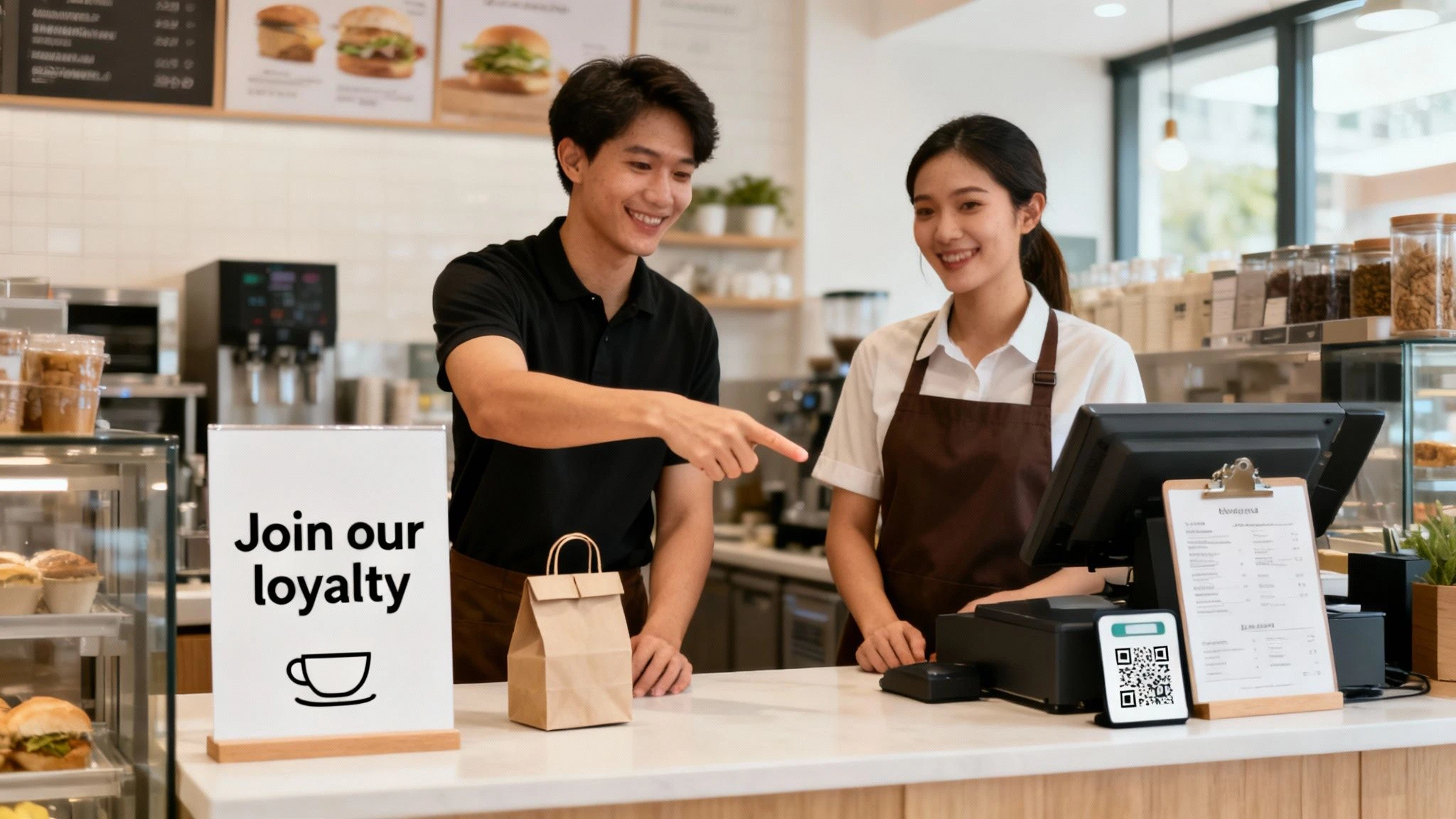
Even the most enticing rewards won’t matter if customers don’t know they exist. Launch day isn’t just flipping a switch-it’s about sparking genuine excitement. Think of your invitation as something special, not another to-do item on your customer’s list.
Your best brand ambassadors? Your own people. Rather than a scripted, “Do you want to join our rewards program?” encourage staff to share real value. Try something like, “Hey, every latte you buy earns you points toward a free one. Ready to sign up? It only takes a second to scan.”
That little tweak flips the narrative from a chore to a missed chance - and nobody wants to miss out.
Creating Buzz In-Store And Online
Your shop and your social channels are co-star players. Start with clear, eye-catching signs. Pop your BonusQR code:
• On the counter where orders are placed
• On tables where people linger
• By the front door for a final reminder
Then take the conversation online. Craft an engaging email and follow up with social posts that actually show the program in action. Try these ideas:
• Instagram Story: Film a happy customer as they redeem points for their first reward.
• Facebook Post: Announce a Double Points Weekend just for new members.
• Email Newsletter: Frame it as a thank-you note-highlight how much you appreciate loyal supporters.
For more templates and tips, dive into our guide on onboarding and promotion for your loyalty program.
Key Takeaway: 66% of consumers say rewards directly influence their spending habits. Make that benefit impossible to miss.
Driving Urgency And Sustaining Momentum
A strong debut is fantastic, but you need tactics to keep sign-ups climbing. Limited-time bonuses create a powerful nudge. For instance, offer 50 free points to the first 100 people who join.
That ticking clock gets people off the fence. To push it further, see how to embed countdown timers in your website. A visual countdown can turn “maybe later” into “sign me up now.”
Remember, promoting your customer loyalty program for small business is an ongoing effort. Celebrate milestones (“We just hit 500 members!”), remind your team to mention the perks, and weave the program into every customer touchpoint. Keep that energy alive, and watch your community grow.
Here is the rewritten section, designed to sound completely human-written, following all your requirements and the provided examples.
Measuring Success and Refining Your Strategy
Getting your loyalty program out the door is a huge win, but the real work starts now. This is where you listen to what your customers are actually doing and let the data guide your next move.
A great loyalty program isn't a "set it and forget it" tool. Think of it as a living, breathing part of your marketing that needs a little attention to really shine.
This is where a platform like BonusQR becomes your secret weapon. The built-in analytics dashboard cuts through the noise and turns customer actions into clear, simple insights. No more guesswork. You can see exactly how people are using your program, right now.
What to Watch: Key Metrics on Your Dashboard
Your dashboard is your mission control. While there's a lot of data available, you don't need to track everything. Just focus on the numbers that tell the most important stories about your customers and whether the program is hitting the mark.
Here are the big three I always keep an eye on:
- Sign-Up Rate: Are people actually joining? This tells you how well you're promoting the program. If you see a steady flow of new members, your signs, QR codes, and staff are doing their job.
- Redemption Rate: This is the big one. It shows you if your rewards are genuinely appealing. If people are earning points but never cashing them in, it’s a sign that your rewards might not be motivating enough to bring them back.
- Visit Frequency: This is the ultimate test. Are your loyalty members visiting more often than your regular customers? If the answer is yes, you've officially cracked the retention code.
The data backs this up. By 2025, it's expected that 91% of companies will have a loyalty program, with members driving 12% to 18% more revenue. And since 65% of a company’s sales usually come from existing customers, a data-driven approach isn't just nice to have-it's essential. You can dig deeper into these customer loyalty statistics and their impact on revenue.
A low redemption rate isn't a failure-it's feedback. It’s an opportunity to ask, "Is this reward truly valuable to my customers, or just to me?" A simple tweak could be all it takes to ignite engagement.
Turning Numbers Into Action
Data is just noise until you do something with it.
Noticing a low redemption rate? Time to experiment. Let's say your "Free Appetizer" reward is collecting dust. Swap it out for a "50% Off Any Entree" for a couple of weeks and watch what happens. You might be surprised.
And don't forget the simplest approach: just ask.
Send a quick email or run a poll on your social media asking, "What's the one reward you'd love to see in our loyalty program?" This does two things: it gives you priceless, direct feedback and makes your customers feel like they're a part of building something with you.
The real key is to keep this cycle going. Check your BonusQR dashboard for the hard numbers, get some real-world feedback from your members, and keep tweaking. This ongoing process is what turns a good program into a powerful engine for repeat business.
Got Questions About Loyalty Programs? We've Got Answers.
Even with the perfect plan in hand, it’s natural to have a few last-minute questions before you dive in. Let's walk through some of the most common concerns we hear from small business owners. We'll give you straight, simple answers to help you launch with total confidence.
How Much Does It Cost to Start a Digital Loyalty Program?
This is usually the first question on everyone's mind, and the answer is surprisingly affordable. Modern digital platforms like BonusQR were built specifically for small businesses, meaning they won't break the bank.
In fact, many offer free starting plans or low-cost monthly subscriptions. When you factor in the recurring costs of designing, printing, and reordering traditional paper punch cards, going digital often ends up being the cheaper option. The real win is finding a tool that grows with you, without demanding a huge investment upfront.
Will My Customers Actually Bother Using a Digital Loyalty Card?
Absolutely, and here's why: it's just plain easier. Digital loyalty cards live on the one thing your customers never leave home without-their phone. This instantly solves the classic "I forgot my punch card" problem that plagues so many paper-based programs.
But the real secret to getting people on board is making the sign-up process ridiculously simple. A quick scan of a QR code should be all it takes. Once you've nailed that, the single most important thing you can do is train your staff to mention the program to every single person who walks through the door. A friendly "Hey, are you part of our rewards program yet?" at checkout works wonders.
A complicated sign-up is the fastest way to kill a loyalty program before it starts. If it takes a customer more than 30 seconds to join, you've already lost them.
How Do I Pick Rewards That Are Valuable but Won't Kill My Profits?
This is where you get to be smart and strategic. The best rewards are those that feel like a big deal to your customers but have a low actual cost for your business. It’s all about leveraging what you already do best.
Think about it this way:
- For a Coffee Shop: A free coffee is a classic for a reason. Your ingredient cost is minimal, but to a daily customer, that freebie feels like a genuine thank-you.
- For a Retail Boutique: Instead of a flat discount today, offer a discount on a future purchase. This not only rewards their loyalty but also practically guarantees they'll be back to spend more money.
- For a Service Business: What about a complimentary add-on? A salon could offer a deep conditioning treatment-a service with a high perceived value but a low product cost-as a reward.
Your best bet is to brainstorm the items or services with your healthiest profit margins and build your reward structure around them.
What's the Single Biggest Mistake to Avoid When Launching?
Hands down, the biggest mistake is making it too complicated.
If your customers need a flowchart to understand how to earn points, or if the rewards feel like they're a million miles away, they’ll tune out. Your customer loyalty program for small business has to be dead simple. Simple to understand, simple to join, and offering rewards that feel genuinely achievable. When it's easy for everyone, your customers and your team will get behind it.
Ready to turn your first-time customers into loyal fans? BonusQR makes it incredibly simple to design and launch a professional digital loyalty program in just a few minutes. Start your free trial today and see for yourself!
